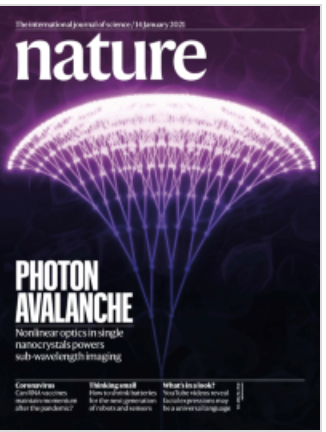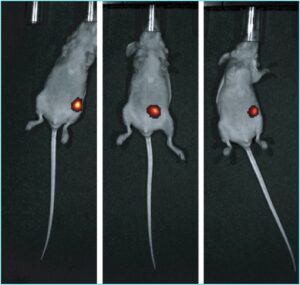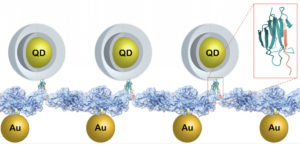Optical microscopy is the primary means of studying complex living systems, enabling real-time analysis of individual cellular components at high spatial and temporal resolution. Inorganic nanocrystals have shown promise as transformative probes for these imaging studies, with exceptional optical properties not found in organic or protein-based probes. Along these lines, we are developing novel nanocrystals as biosensors and single-molecule probes, improving bioconjugation and targeting chemistries, and imaging live cells with these reagents. We aim to integrate the development of novel luminescent nanomaterials into multidisciplinary efforts to address significant biological questions of cell function.
Imaging nanoparticles in living systems
Upconverting Nanoparticles
Lanthanide-doped upconverting nanoparticles (UCNPs) sum the energies of 2 incident NIR photons to emit one at visible wavelengths, an unusual property unlike anything found in the cell. UCNPs have significant advantages over other luminescent reporters, including an absence of on–off blinking, single-molecule multiphoton NIR excitation at powers approaching those used for standard one-photon confocal imaging, no overlap with cellular autofluorescence, and no measurable photobleaching under prolonged single-particle excitation. The NIR excitation of UCNPs is useful for deep tissue imaging, mm into tissue.
above left: imaging Victor’s QD-antibody conjugates in live breast cancer cells, from: Immunotargeting of Nanocrystals by SpyCatcher Conjugation of Engineered Antibodies. ACS Nano 15, 8374 (2021)
above right: imaging Bella’s alloyed Yb/Er UCNPs in mammary fat pads 3 mm deep in anesthetized mice, from: Low irradiance multiphoton imaging with alloyed lanthanide nanocrystals. Nat Comm 9, 3082 (2018)
Extreme nonlinearity with avalanching nanoparticles
Avalanching nanoparticles (ANPs) are UCNPs with the steepest nonlinear emission response of any nanoscale material. Along with our team of collaborators, we first reported ANPs at the start of 2021 (as a Nature cover) and have published multiple Nature and Nature Photonics papers on applications of their extreme nanooptics. These include indefinite all-NIR photoswitching that enable sub-Angstrom superresolution precision, the first realization of intrinsic optical bistability, in which the ANPs show optical memory, and the use of ANPs as force sensors that can image forces with a dynamic range of over 4 orders of magnitude.
above: a 3-ANP cluster imaged with photoswitching superresolution technique INPALM, with sub-nm localization accuracy, from Indefinite and Bidirectional Near Infrared Nanocrystal Photoswitching. Nature 618, 951–958 (2023)
Infrared nanosensors of pico-to micro-newton forces. Nature in press (2024).
Intrinsic Optical Bistability of Photon Avalanching Nanocrystals. Nature Photonics in press (2024)
Giant nonlinear optical responses from photon avalanching nanoparticles. Nature, 589, 230–235 (2021).

Nanocrystal Surface Chemistry
Improved biocompatibility and targeting
Broadening the scope of the chemical reactions we can run on nanocrystal surfaces is essential to expand their reach for imaging applications. High-quality UCNPs and quantum dots are synthesized in hydrophobic solvent and must be transferred to water and made biocompatible to have any utility as imaging probes or biosensors. An ongoing challenge in applying nanocrystals as probes for cellular imaging is improving their aqueous passivation and developing new reactions that work on nanocrystal surfaces. A growing area of research for us is development of new bioconjugation chemistries, including click reactions, protein self-ligation, and bioorthonganol reactions for immunotargeting.
above left: learning how to run Cu Click reactions on QD surfaces: Azide-Alkyne Click Conjugation on Quantum Dots by Selective Copper Coordination. ACS Nano 12, 4469–4477 (2018)
above right: using SpyCatcher for NPs: Controlled and Stable Patterning of Diverse Inorganic Nanocrystals on Crystalline Two-Dimensional Protein Arrays. Biochemistry 60, 1063-1074 (2021)





